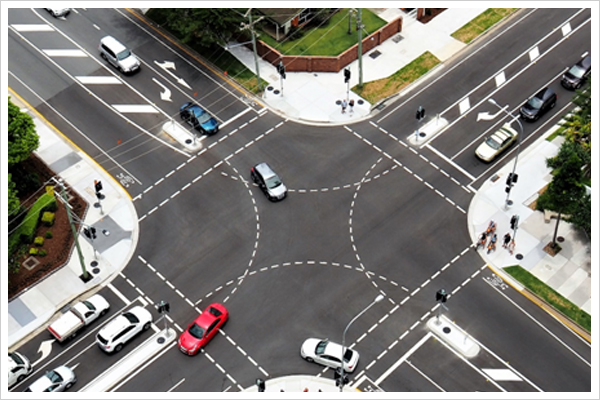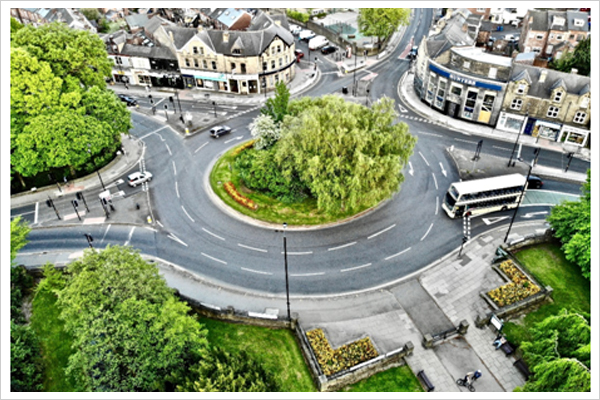

Traffic Engineering wing of Microtrans have the knowledge and experience required to deliver a comprehensive traffic signal design package. This package includes site feasibility studies, traffic count and classification, preliminary design, concept development, selection of technology, product specification, construction advice for Traffic Signal system and detail modelling of individual junction and complex networks.
Our Traffic Engineering wing of highly trained and experienced engineers and consultants with a proven track record of delivering Intelligent Traffic Solutions (ITS) across the country is dedicated to providing support to our customers at all stages of the Project from strategy, planning and concept through to implementation, service delivery and continuous improvement. Our Traffic Design package also cover pre and post implementation surveys, micro and macro simulations to evaluate the effectiveness of improvement proposals and implemented solutions.
Our intersection traffic engineering studies includes
Our coordination with local stake holders such as Municipal Corporation, Traffic Police, Public Transport Organization and Citizen representative and preparing technical presentation to senior level decision makers is a part of our work methodology
CROSSWALKS AND CROSSINGS
The Crosswalks is designed to offer as much comfort and protection to pedestrian as possible based on multiple factors, including land uses, present and future demand, pedestrian compliance, speed, safety and crash history. Safe and frequent crosswalks support a walkable urban environment. Crosswalks is applied where the pedestrian traffic is anticipated and encouraged. We take into account both existing as well as projected crossing demand. Frequent crossings reinforce walkability and have the potential to fuel greater demand. Where signalized or stop-controlled pedestrian crossings are not warranted but demand exists or is anticipated, we continue to work toward goals of safety and comfort for people walking through other means, such as actuated crossings or enhanced crossing treatments.
CORNER CURB RADIUS
Determine corner radius based on the intersection geometry only. Corner radius directly impact vehicle turning speeds and pedestrian crossing distances. Minimizing the size of a corner radius is critical to creating compact intersections with safe turning speeds. While standard curbs are 10–15 feet. Corner Curb is crucial to pedestrian safety, as corners are where drivers are most likely to encounter pedestrians crossing in the crosswalk.
VISIBILITY / SIGHT DISTANCE
Intersection design should facilitate eye contact between road users, ensuring that motorists, bicyclists, pedestrians, and transit vehicles intuitively read intersections as shared spaces. Visibility can be achieved through a variety of design strategies. Visibility and sight distance are important elements of consideration to inherent safety of intersections, driveways and other potential conflict points. Many factors improve intersection visibility, wide corner with large sight triangles may create visibility and traffic control devices must be unobstructed in the intersection and shall be free of tree cover or visual clutter
TRAFFIC SIGNALS
Traffic signal timing is an essential tool, not just for the movement of traffic, but also for a safer environment that supports walking, bicycling and public transportation. Traffic Signals govern how road operate and how well they provide mobility, safety, and public space.
Leading Pedestrian Interval
A Leading Pedestrian Interval (LPI) is used at intersection where heavy turning traffic comes into conflict with crossing pedestrians during the permissive phase of the signal cycle. LPIs are typically applied where both pedestrian volumes and turning volumes are high enough to warrant an additional dedicated interval for pedestrian only traffic. LPIs enhance the visibility of pedestrians in the intersection and reinforce their right-of-way over turning vehicles.
Signal Cycle Lengths
Traffic Signal cycle length have a significant impact on mobility and pedestrian crossing at intersection. Short signal cycle lengths of 60-90 seconds are ideal for urban areas. Long signal cycles, compounded over multiple intersections, can make crossing a street or walking even a short distance prohibitive and frustrating. This discourages walking altogether, and makes streets into barriers that separate destinations.
Fixed vs. Actuated Signalization
In general, fixed-time signals are the rule in urban areas for reasons of regularity, network organization, predictability, and reducing unnecessary delay. In certain, less-trafficked areas, actuated signals (push buttons, loop detectors) may be appropriate; however, these must be programmed to minimize delay, which will increase compliance. Actuated signals in general are not preferable because of the maintenance requirements and upkeep of the detection on the street. Fixed-time signals incur lower initial and ongoing maintenance costs than actuated signals.
Coordinated Signal Timing
Coordinated signal timing synchronizes traffic movements and manages the progression speed of specific modes where uninterrupted flow is desired along a corridor. While traditionally applied to increase vehicular traffic flow and reduce peak-hour delay, coordinated signal timing can also be optimized for slower speeds, creating an uninterrupted flow for bicyclists or low vehicle progression speeds for a pedestrian-friendly downtown. Signals may also be timed to coordinate transit headways along routes where regular transit service is consistent and has low variability.
Keyword : Planning and Consultation, Intersection design planning and consultation, Intersection Mobility Design, Junction Improvement Plan and Consultation, Junction traffic management plan, Junction traffic consultation, Traffic Junction traffic solution consultancy, Traffic signal planning and consultancy